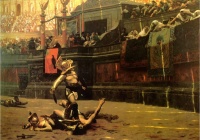Mass society
From The Art and Popular Culture Encyclopedia

Illustration: Pollice Verso by Jean-Léon Gérôme, 1872
|
Related e |
|
Featured: |
Mass society is a description associated with society in the modern, industrial era. Desciptions of society as a "masses" took form in the 19th century, referring to the leveling tendencies in the period of the Industrial Revolution that undermined traditional and aristocratic values.
In the work of early 19th century political theorists such as Alexis de Tocqueville, the term was used in discussions of elite concerns about a shift in the body politic of the Western world pronounced since the French Revolution. Such elite concerns centered in large part on the "tyranny of the majority," or mob rule.
In the late 19th century, in the work of Émile Durkheim, the term was associated with society as a mass of undifferentiated, atomistic individuals.
In 20th century neo-Marxist accounts, such as those of the Frankfurt School, mass society was linked to a society of alienated individuals held together by a culture industry that served the interests of capitalism.
Conservative accounts in the 20th century critqued mass society from a different perspective. José Ortega y Gasset, for instance, lamented as the decline of high culture in mass society.
See also


